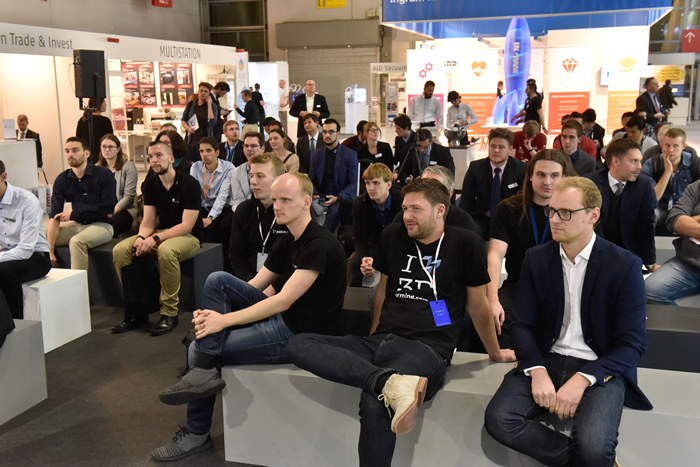![formnext attendees attending a conference session [Image: Mesago Messe Frankfurt GmbH]](https://fabbaloo.com/wp-content/uploads/2020/05/AM_formnext_79_img_5eb0a3d488859.jpg)
There seem to be three broad approaches to entering a career in additive manufacturing.
From what I’ve observed personally and heard through countless conversations, these three very general approaches include:
-
“I just found myself here”
-
Innovation / invention
-
Intentional
Of these, the first has been a common story (indeed, it’s my story), while the second has driven advances. Increasingly, though, we’re seeing entrants to the industry fully equipped to enter with pre-workforce training and perhaps even a dedicated degree.
I guess I work in additive now
For many of us, work in additive manufacturing was never the answer to “What do you want to be when you grow up?” — because it wasn’t an option.
Granted, I’m about as old as 3D printing, so technically it was an option throughout my lifetime, but after the early-to-mid-’80s saw the invention of SLA and FDM technologies, it was still a process for technology to become industry. A niche, nascent sector of manufacturing, 3D printing took some time to take hold.
It gained significant public notice around 2012 — a year now better known as the beginning of the hype bubble that endured for about three years. Significant attention in the popular media, including rockstar appearances at CES and a perception of “a 3D printer for every home”, drew participation and investment. It was during this period (2014 to be precise) that investment met opportunity as I entered what would become a career track in the industry. With degrees in English and theatre, my résumé may not have seemed tailored to additive manufacturing, but a background in creative arts and communication added to years working in industry research led to a surprisingly neat fit in tech journalism.
I share my story because it turns out it’s not uncommon; I saw a job listing that aligned well enough with my educational and workplace backgrounds and applied. And four years ago I said, “I guess I work in additive now.”
Innovation in an innovative field
3D printing had to get a start somewhere. Early related research can be traced as far back as the 1960s, while the technologies we know and employ today have their origins more in the 1980s. We’re familiar with many of the names of the pioneers of what would become additive manufacturing — and becoming familiar with even more as the technology suite continues to expand.
Taking idea to reality is the underlying foundation of innovation, and those who do — the engineers, the entrepreneurs, the inventors — are the ones laying that foundation.
Whether formal lab-driven R&D efforts or tinkering in a garage, innovative minds have led to the Next Big Thing time and time again, and 3D printing is no different here. Rethinking manufacturing from conventional subtractive or molding formats into a layer-by-layer, jetted, or sintered technique required driven mindsets and the science to back them up. Many of those coming into the earliest days of the industry count innovation as a key tenet of their journey, on both the invention and the business-minded sides of the story.
Innovation remains a primary driver, as startups are frequently seen in additive manufacturing, building upon existing technologies, filling emerging needs, and introducing wholly new approaches.
Intention to work in additive manufacturing
In the former two scenarios, employment in 3D printing comes as a new thing, either experientitally or created. Now we see the third wave: those trained for a career in additive manufacturing.
Increasing industry focus, the spread of STEAM (science, technology, engineering, arts, mathematics) -driven curricula and initiatives from elementary through upper education, workforce upskilling, apprenticeships, and dedicated degree programs are training the next generations for careers in 3D printing.
The first time I met someone with a masters in AM was at TCT Show 2017. The early-twenty-something young man represented a step forward, as he had classroom and practical experience focused completely on additive technologies. Such programs are becoming wider-spread — though still relatively rare — across the world as upskilling and training for careers in Industry 4.0 become major focuses.
That students are seeking intentionally to study additive manufacturing speaks to a growing maturity in the industry: it is a career path, and a viable course of study. Expanding programs, from webinars to one-day seminars in design for additive manufacture (DfAM) to free and paid online courses to full-out degree-path programs, showcase the rising demand for expertise in this area of technology. The skills gap remains a significant barrier to wider adoption in additive manufacturing, and educational and professional initiatives are increasingly being put into place to address this challenge, with promise for the future of the industry.
The additive workforce
The additive manufacturing workforce is itself also a growing area of study, with reports examining its shape on the rise. I author a quarterly report for Women in 3D Printing highlighting diversity in employment, for example, while Alexander Daniels Global looks to hiring patterns and salary trends, and more expert-led white papers are currently in process to delve into this dynamic workforce.
As such studies continue to expand, and hiring continues with increasingly well-trained candidates, we’ll see the shape of entry into additive manufacturing continue to shift as the third wave becomes more of a norm.











